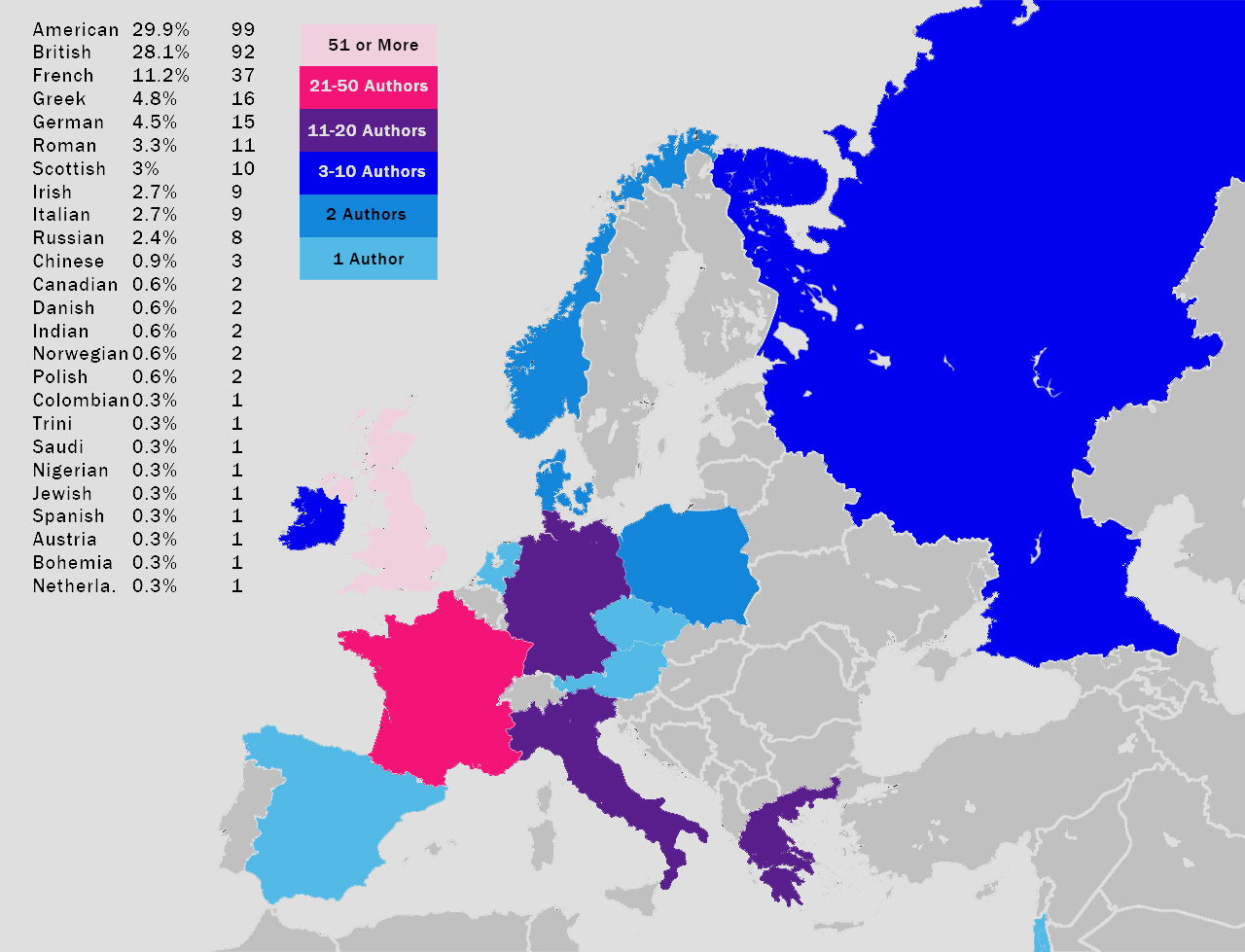(CANON) AGGREGATE
Authors
Aside from the works themselves, we could reasonably consider the AC a canon of authorship. This chapter will examine the AC's statistics not according to top works, but rather top authors, in order to enumerate and analyze their contributions to the canon in total. There are, of course, far too many authors to examine them all (331 unique authors in total), so we will limit our analysis to the top authors (both in terms of CR and in terms of contributions), as well as point out some unique and interesting individual statistics that cropped up whilst organizing this information. Note that two versions of many charts will be presented: one in which Shakespeare is included, and one in which he is not; the reason for this, as outlined in Chapter One, is simply because of his canon-warping presence. An extreme statistical outlier, Shakespeare alone contributes more to the canon than several hundred years' worth of authors (his 29 contributions are more than the sum total of the 1st-15th centuries, more than half of all texts in the 18th century, and only one text short of all of human literary history in the BC era). Further, his CR (624) is more than five times that of the next closest author (Jane Austen, 147CR) and more than the next six authors combined (Austen (147CR), Dickens (107CR), Orwell (91CR), Poe (88CR), Woolf (80CR) and Joyce (73CR)). Suffice to say, Shakespeare stands alone at the top of the author list, though, with the implementation of some advanced statistical metrics, perhaps not quite as far as this apparent statistical dominance might indicate.
The Top Authors
As you might expect, there is a rather clear correllation between top authors and top texts. The highest-scoring texts come from the highest-scoring authors...usually. This, however, is not always the case, and, interestingly enough, the number of contributions an author makes to the canon is seemingly not at all tied to his or her eventual overall CR. With the notable exception of Shakespeare, the data seems to suggest that canon-makers prefer texts over authors, one reason the AC is ranked accordingly. Some authors with considerable constributions to the AC include Aristotle (8), Charles Dickens (8), William Faulkner (7), Edgar Allan Poe (7), Ernest Hemingway (6), Henry James (5), Fyodor Dostoevsky (5), Jane Austen (5), Sophocles (5), and Joseph Conrad (5). These are the only authors with 5 or more texts represented within the AC, and with the notable exception of Aristotle, none ranks below 42CR (Henry James). Having even more than one text appear on the AC is an accomplishment, as only 90 authors of the accumulated 331 (27.1%) accomplish this feat, with the remainder of the canon comprised of "one-hit wonders": 241 authors (72.8%), including some major names, like both Emily and Charlotte Bronte, Dante Alighieri, Mary Shelley, J. D. Salinger, Harper Lee, Bram Stoker, Voltaire, Virgil, and Ovid. One unique addition to this "one-hit wonder" list is American poet Walt Whitman, who published, edited, and re-published the same text repeatedly throughout his lifetime, making for only a single eligible inclusion, his poetry anthology Leaves of Grass (50 overall, 26CR).
The favorite within UR (university and pedagogical preference) was once again Shakespeare, with 170UR. Behind him is a fascinating look at the most valued authors at the university level, with Virginia Woolf in at number two (39UR), William Faulkner at number three (34UR), Sophocles at number four (34UR), Homer at number five (31UR), and James Joyce at number six (30UR). Beyond this is a steep drop to number seven (Toni Morrison, Herman Melville, Plato, and Dante, all tied with 23UR apiece). These statistics are vastly different from the authors preferred within generic lists, which again sees Shakespeare lead (454GR), followed by Austen (126GR), Dickens (98GR), Orwell (72GR), and Poe (66GR), before another dropoff occurs to the seventh position (Dostoevsky, with 54GR). The highest-scoring non-Shakespeare English author was Jane Austen (147CR), the highest-scoring American author was Edgar Allan Poe (88CR), the highest-scoring translated author was Homer (72CR), and the highest-scoring minority author was Toni Morrison (46CR).
Note that these author statistics also account for anonymous authors, of whom there were eight on the AC, responsible for Beowulf (78 overall, 20CR), The Epic of Gilgamesh (200 overall, 9CR), The Nibelungenlied (264 overall, 6CR), Sir Gawain and the Green Knight (293 overall, 5CR) The Summoning of Everyman (370 overall, 3CR), The Volsung Saga (371 overall, 3CR), The Thousand and One Nights (166 overall, 12CR), and The Song of Roland (372 overall, 3CR). Further, there are a series of authors within the list for whom much of their work is collected into an anthology and adopted into the AC thusly. If those works were to be separated, perhaps they would score higher (or lower!). In any case, they would certainly be responsible for more constributions to the list, if not more CR. Primarily poets and authors of fairy tales and morality tales, these notable anthology authors include William Wordsworth and Samuel Taylor Coleridge, the aforementioned Walt Whitman, Emily Dickinson, Anton Chekov, Michel de Montaigne, Hans Christian Anderson, Jakob and Wilhelm Grimm, Guy de Maupassant, William Blake, John Keats, Ovid, Jacques Prevert, and Charles Baudelaire, amongst others.
Two unique authors stand out amongst the pack as two sides of the same coin. One, Aristotle, is responsible for the second-most contributions to the AC (8), but his combined CR (29), ranks him at position 48 overall, giving him one of the lowest average CRs across multiple texts amongst qualifying authors (qualifying authors include those with 3 or more texts on the AC). He ranks higher in CR amongst qualifying authors only above Albert Camus (24CR), Tennessee Williams (24CR), and Euripides (26CR), while 26 other authors, beginning with Thomas Hardy (32CR) place above him. This strange dichotomy is difficult to explain, although I suspect Aristotle might be a victim of his own success. Much like Shakespeare and Dickens, the only other AC authors near him in terms of contributions, Aristotle wrote about everything, and did so at length. This means that contrary to some authors for whom their life's work is in a single volume (Whitman, Dickinson, or Dante, for example), Aristotle's support is spread across numerous entries. Another potential explanation could be that his most popular volumes, Poetics and Politics, were suitable entries for the AC, and support for his other work grew until it was also included, if not thoroughly supported popularly. Most of his textual support is in the form of 2CR, split equally between UR and GR, including De Anima, On Generation and Corruption, Nichomachean Ethics, and Physics. He may also be a victim of the AC's preference for fiction, as you'll no doubt note, Aristotle wrote no fictional pieces that appear on the AC.
The other unique author is in the opposite position, having only a few texts that are equally lauded, a task not easily accomplished. Typically, with the trite exception of Shakespeare, authors tend to have a single magnum opus, or masterwork, which supports their plaudits. Then, additional texts may be included because of the author's influence. This process may be seen with Vonnegut (Slaughterhouse-Five (74 overall, 21CR) brought Cat's Cradle (307 overall, 4CR) along with it) or Fitzgerald (The Great Gatsby (2 overall, 57CR) brought along Tender is the Night (221 overall, 6CR). In this case, however, our anti-Aristotle author, George Orwell, has the highest score amongst qualifying authors across all texts, giving him the highest average CR amongst qualifying authors. Orwell clocks in at a whopping 30.33 average CR for his three entries to the AC, just beating out Jane Austen's 29.40 average and Shakespeare's 21.52 average. The highest score, regardless of contributions, in this category goes to Charlotte Bronte, whose single entry (Wuthering Heights) scored 55 recs, giving her an average of, of course, 55, followed by fellow singletons Emily Bronte (49), Dante (48), Mary Shelley (42), Salinger (42), and Harper Lee (41). Orwell's high average demonstrates that not only did he add multiple texts to the AC, but he did so consistently with high quality. His entries are 1984 (6 overall, 51CR), Animal Farm (31 overall, 32CR), and Shooting an Elephant (212 overall, 8CR).
The chart below details the candidates for "top author" on the AC, arranged according to CR, with only the top 20 CR-scoring authors included. Additionally, only qualifying authors (those with 3 or more contributions) have been included.

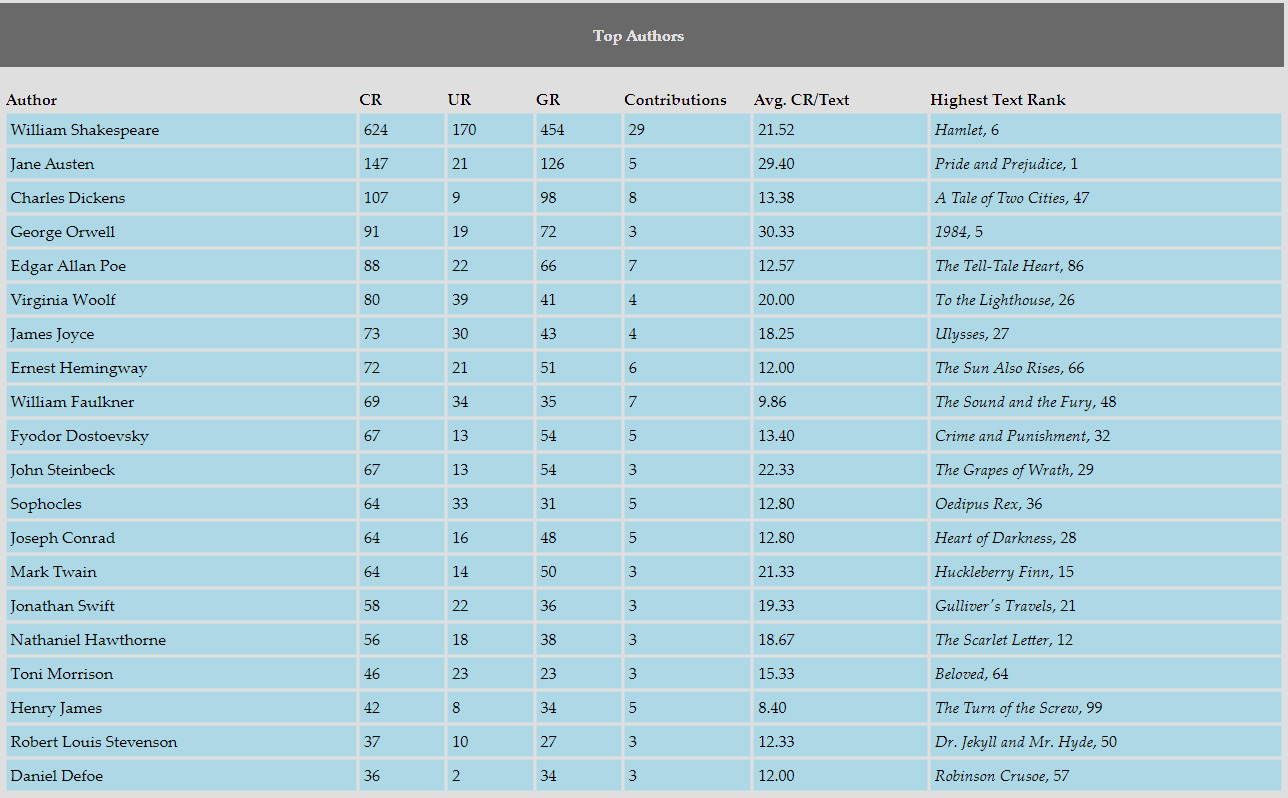
The Podium
It is certainly counter-productive to proclaim a "best" author within the context of the AC. After all, as I've stated numerous times, the term "best" is almost altogether meaningless, encompassing criteria as diverse and potentially nebulous as "best-selling," "most influential," "most quoted," "most taught or assigned," "most read," and "most well-liked," in addition to things like "most historically relevant" or "most traditionally accepted." This means that ranking a "best" author, without specificity, would be something of an impossibility. Further, I urge anyone reading this project to avoid the temptation to do the same, strong as it may be. Instead, the "podium" to which the heading refers indicates which authors have the strongest influence on the AC. Anyone, and everyone, is free is disagree and substitute their own qualifiers and/or results herein (remember: popularity contest!), and the viewpoint would remain equally valid.
With this disclaimer out of the way, let's look at some more data, and examine which authors, statistically speaking, make the biggest mark on the AC. A case could be made, in my opinion, for six individuals as the most integral to the AC. First, we'll go through each option, as well as their resumes, and then we will attempt to rank them according to the data we've collected.
William Shakespeare. Shakespeare makes a strong case for the most influential author on this list, and in fact, would likely be most readers' first choice. So influential is he that his statistical outliers have forced me to alter graphs to keep everything on the same scale. He has more than triple the CR of the next highest author (Austen). He has more CR (624) and more works (29) than the next six authors combined. He leads the AC in university recs by even more, holding almost six times the number of UR over the next highest author (Virginia Woolf). He is the number one most popular author in two separate centuries. He holds the top seven highest-scoring drama texts. His work accounts for three of the top ten (30%), five of the top twenty (25%), and 10 of the top one hundred (10%). His CR rating alone accounts for 11% of every CR on the entire AC. He has more recs than many centuries of authors. His CR/work average is fourth-best on the AC at 21.52.
Jane Austen. Austen is the highest-scoring female author on the AC, handily defeating the second-place woman (Virginia Woolf) in both CR (147 to 80) and works (5 to 4). Austen has five works in total, tied for sixth overall in contributions. She was the most popular author in the second-most competitive century (19th). Her CR/work is far higher than Shakespeare, at 29.40, good enough for second all-time, losing out only to George Orwell, and she offers more texts than he does. Her primary contribution, Pride and Predjudice, is the number one most popular text of all time, according to the AC. This also means, coincidentally, that she owns the most popular novel ever and the most popular work of fiction ever with that same text. Her CR is lower only than Shakespeare, making her second overall on the entire AC, and she managed repeated success when most of her contemporaries managed only a single work, or two, on the AC. Austen more than doubled their output.
George Orwell. Orwell doesn't have the raw statistical power of Shakespeare, or the single luminary text of Austen. Instead, he has consistently high quality across a multitude of works. Amongst qualifying authors (3 or more contributions to the AC), Orwell has the highest average CR of all time, scoring a 30.33, enough to defeat Austen by a few percentage points, and enough to firmly defeat Shakespeare. This metric means that each of Orwell's texts scores higher, on average, than anything either of our other two authors have written, save, of course, for Pride and Prejudice, and also that each of Orwell's texts scores higher than almost 70% of the entire canon. Additionally, his sustained success came in the most competitive century (20th), and Orwell was both the most popular British author and the most popular overall in that time period. His seminal text, 1984, is the second-most popular text in the entire 20th century (behind only Fitzgerald), and it went on to inspire an ad campaign (Apple) and a new genre (dystopia). Alongside 1984, his text Animal Farm (28 overall, 32CR) makes him the only other author aside from Shakespeare to appear more than once in the Top 30.
Charles Dickens. Dickens is perhaps most famous for his highest-scoring work, A Tale of Two Cities, but this is far from his only contribution. Rivaled by only Aristotle (who is several tiers below our highest ranked authors), Dickens is second only to Shakespeare in terms of contributions to the AC, with 8. His CR is third overall of all authors, and although it is quite behind Austen, without Pride and Prejudice to bolster her score, Dickens is the higher scoring of the two. Further, Dickens accomplished his scores without support of the university system. He is one of only three authors within the top twenty (the others being Henry James and Daniel Defoe) to score so highly with only a single-digit UR (9). This means that his texts are read and enjoyed by a higher percentage of individuals than anyone else on the list, rather than being considered seminal by the educational system. His highest scoring text, the aforementioned A Tale of Two Cities, ranks in the top 50 overall on the AC. His other texts, David Copperfield (94 overall, 18CR), Great Expectations (103 overall, 17CR), A Christmas Carol (104 overall, 17CR), Bleak House (165 overall, 12CR) and Oliver Twist (177 overall, 11CR), all rank in the top 30% of the AC and have double-digit CR. He even adds a further two texts, Pickwick Papers and Nicholas Nickleby, further on in the canon.
Edgar Allan Poe. Poe makes a case as most integral to the AC for two primary reasons: he is the most popular American author of all time, and the most prolific short-story writer of all time. Further, he is tied with Faulkner for third-most contributions to the AC (7), behind only Shakespeare, Aristotle, and Dickens. His highest-scoring text is The Tell-Tale Heart (86 overall), and although this position wouldn't be enough to consider him for this list, he does have the highest-ranking short story of all time with The Fall of the House of Usher. He adds an additional three short stories to the AC (The Cask of Amontillado, The Pit and the Pendulum, The Masque of the Red Death), giving him more entries into the format than the runner-up in this category, William Faulkner (2 works, A Rose for Emily and Barn Burning). Further, as the canon is primarily US authors, Poe leads the charge in the most competetive demographic category. His 12.57 CR/Work is roughly equal that of Dickens' 13.38, both suitable numbers for authors that have such large contributions to the AC. Finally, Poe is easily the most varied author within our candidates. Whereas each author previously focused on one or two formats, Poe scored highly for each format in which he wrote, scoring AC entries for short stories (as listed), novels (Narrative of the Life of Arthur Gordon Pym), poetry (The Raven), and novellas (The Tell-Tale Heart).
Virginia Woolf. Perhaps a tier below our other authors, Woolf makes a strong showing for a podium finish on the strength of her statistical representation. She doesn't possess the utter statistical dominance of Shakespeare, the single seminal work of Austen, the high average of Orwell or Dickens, or the variety and demographic excellence of Poe. Instead, she scores highly on each and every one of those relative statistics, a factor that no other author, even Shakespeare, can claim. Woolf is seventh overall in CR, and tied for seventh in contributions (with 4). Her CR/Work is 20, just lower than Shakespeare, and higher than Poe and Dickens. She is second only to Aldous Huxley as the most popular British writer of the 20th century. She helped define the genre of modernism alongside T. S. Eliot and James Joyce. She is the most popular female author of the 20th century, and second only to Jane Austen all-time. Her highest-scoring work, To The Lighthouse, is the 26th most popular text of all time and the 13th most popular novel of all time. She is second only to Shakespeare in terms of UR. Consistent excellence, rather than shattering success, defines Woolf's writing career.
 The previous chart displays CR statistics and number of contributions to the canon for our top six author candidates. It can be difficult to envision Shakespeare's absolute dominance in terms of sheer numerical prowess, so this chart should help us visualize that dominance. Note, of course, as listed in our categories to the left, this is not the only metric for whom an author should be judged. Further, note again the nature of tradition. Since Shakespeare has been read for so long and by so many, his adoption into the AC is almost expected. It is something of a judgment call as to which is more impressive: the "staying power" of a text remaining on the AC for so long, or newer texts, which may be influenced by recency bias (as detailed in Chapter Two), rocketing to the top in a shorter time and without the aid of tradition. Subjective metrics like these just continue to demonstrate that selection of a "best" author on the AC is a futile endeavor, even if one, or more, demonstrates statistical excellence. I am reminded, coincidentally, of subjective arguments that take place in the world of sports (for MVPs, arguments about the greatest of all time at a position), etc., and those arguments are as much fueled by personal preference as this one is.
The previous chart displays CR statistics and number of contributions to the canon for our top six author candidates. It can be difficult to envision Shakespeare's absolute dominance in terms of sheer numerical prowess, so this chart should help us visualize that dominance. Note, of course, as listed in our categories to the left, this is not the only metric for whom an author should be judged. Further, note again the nature of tradition. Since Shakespeare has been read for so long and by so many, his adoption into the AC is almost expected. It is something of a judgment call as to which is more impressive: the "staying power" of a text remaining on the AC for so long, or newer texts, which may be influenced by recency bias (as detailed in Chapter Two), rocketing to the top in a shorter time and without the aid of tradition. Subjective metrics like these just continue to demonstrate that selection of a "best" author on the AC is a futile endeavor, even if one, or more, demonstrates statistical excellence. I am reminded, coincidentally, of subjective arguments that take place in the world of sports (for MVPs, arguments about the greatest of all time at a position), etc., and those arguments are as much fueled by personal preference as this one is.
The Other Best Author
A special mention should be made here to note that, despite its relative unpopularity amongst the AC, a highest-scoring nonfiction author is also worth examining. Again, multiple possibilities exist, ranging from Aristotle (most contributions) to Plato (most CR in nonfiction) to Thoreau (highest-scoring nonfiction text by CR (Walden, 34 overall, 30CR)). This division also further illustrates the tendency to group the canon into differential categories in an attempt to avoid an "apples and oranges" type of comparison. I resist the urge to do so in other spheres, as too many divisions would run contrary to the aims of this project and would only prove to be further subjective editorial decisions shaping the data, but a fiction/nonfiction split seems logical. The chart below illustrates the split between fiction and nonfiction texts, and as you can see, fiction, in addition to dominating the top half of the AC by CR, also dominates the AC as a whole in terms of textual contribution. Perhaps a case could be made that nonfiction should be a subset AC, but it is included on the primary list precisely so that we may see interesting statistical metrics like this one.
The answer to "most influential nonfiction author" may even go to "anonymous," as the King James Bible, the highest-scoring anonymously-written text, is not at all accounted for in these rankings. Subjectivity abounds, and that's a good thing.
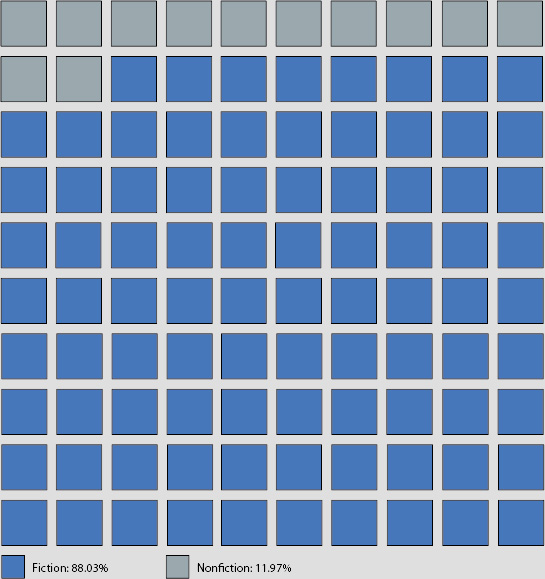
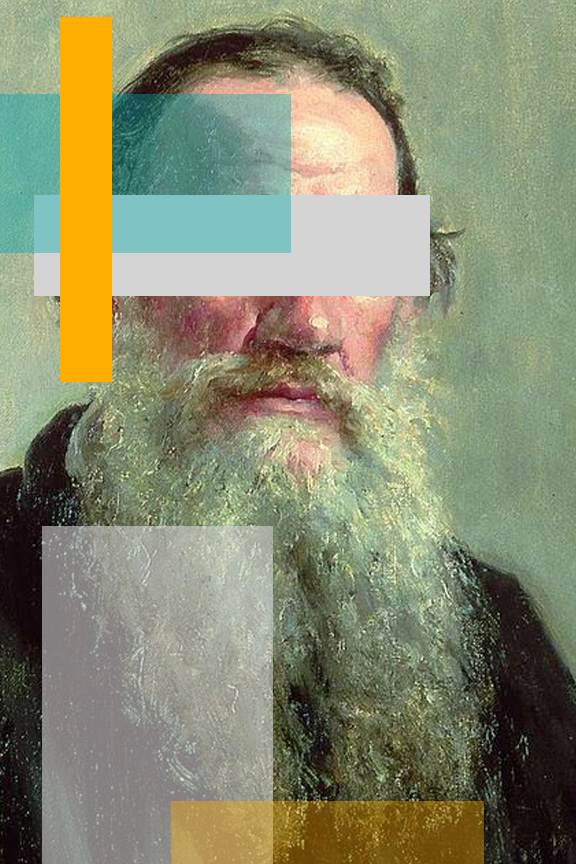
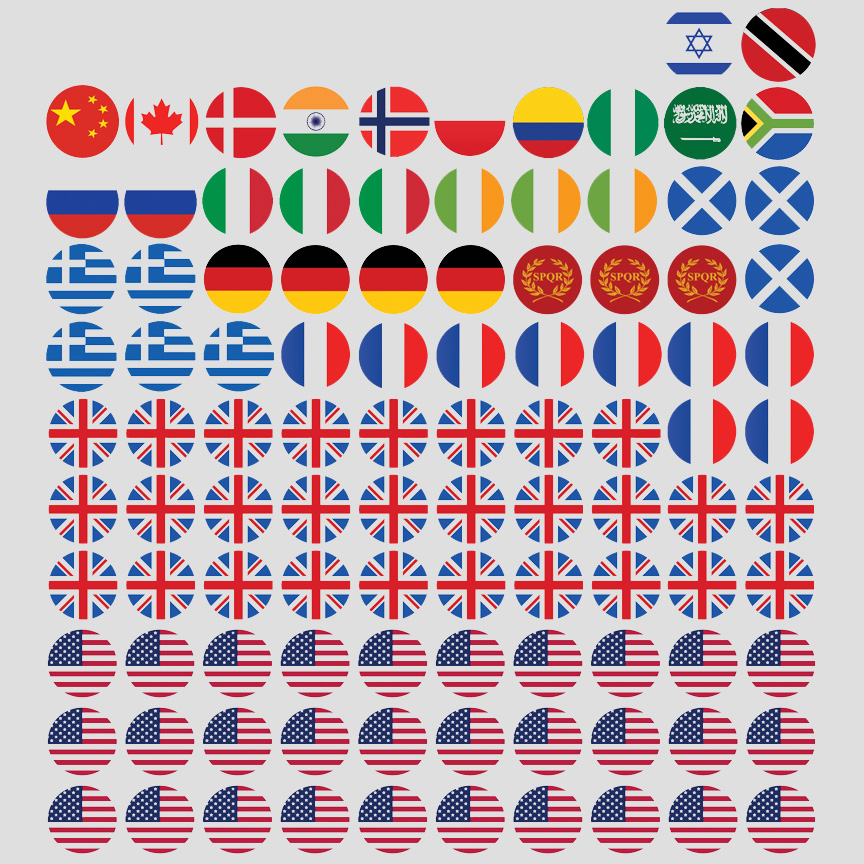
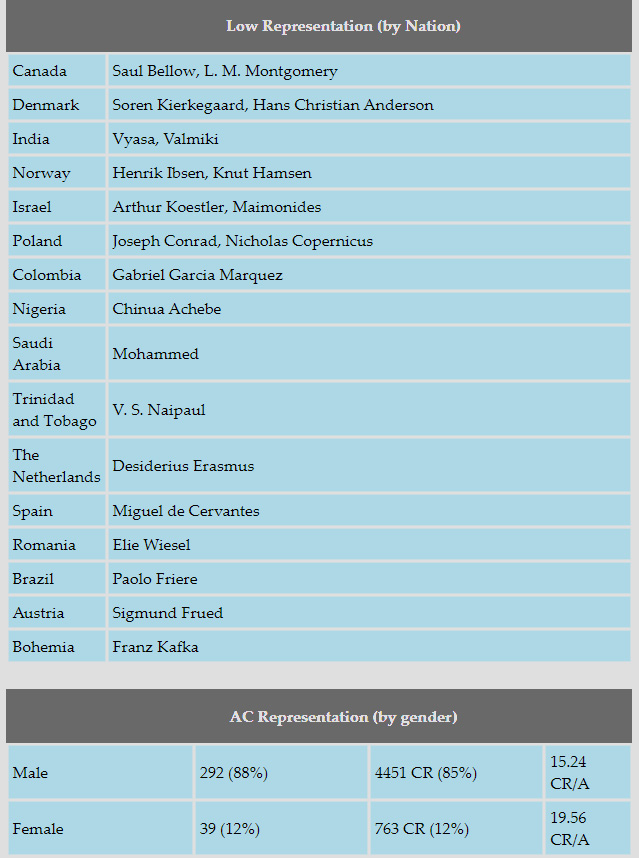 I have no explanation for this strange duality, wherein it could reasonably be argued that both male and female authors are more popular amongst the AC, depending upon which metric we use to score them. Male authors account for more works on the canon by a wide margin, as well as higher total CR scores and more works in the top 100. Female authors, on the other hand, enjoy stronger, more concentrated support, a higher CR/author ratio, and more of the top spots in Tier A, including two of the top three.
I have no explanation for this strange duality, wherein it could reasonably be argued that both male and female authors are more popular amongst the AC, depending upon which metric we use to score them. Male authors account for more works on the canon by a wide margin, as well as higher total CR scores and more works in the top 100. Female authors, on the other hand, enjoy stronger, more concentrated support, a higher CR/author ratio, and more of the top spots in Tier A, including two of the top three.